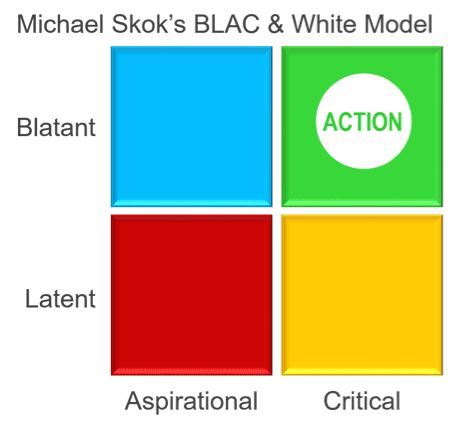Stop the Frustration! Move Prospects and Clients to Take Action

What does it take to move a prospect or client to take action?
Psychologists have been telling us for years that there are two main motivators of action for human beings:
- Prevent or Eliminate a Problem
- Take Advantage of an Opportunity
It’s my understanding that most psychologists and neuroscientists would agree that preventing or eliminating a problem (pain) is the more powerful of these two motivators. This is why most sales trainers will tell you to “go for the pain.”
Some old-school trainers will tell you to “twist the knife until it hurts.” I find that rather extreme language, don’t you?
Michael Skok is a venture capitalist based in Boston and founder of the firm Start Up Secrets (www.StartUpSecrets.com). Skok has created a simple, yet brilliant, model that you can use to determine if the problem you are attempting to solve is worthy of your time and attention, and if your prospect or client is likely to take action to fix that problem.
Michael Skok’s “BLACK and White Model”
One axis on Skok’s model asks if the problem Blatant or Latent.
If the problem is Blatant… obvious… easily recognizable… that’s a good thing, for all concerned. When the prospect or client knows they have the problem, you don’t have to spend too much time digging it out of them. You state it – their head starts shaking “yes.”
You’re relevant. You have their attention. If you demonstrate that you might have a fix for this problem, you might just retain their interest long enough to move them to action.
On the other hand, if the problem is Latent… hidden… not clearly recognizable or understood, then you have some work in front of you.
For example, many folks are unaware of the importance of certain types of insurance, such as Disability Insurance (DI) and Long-Term Care Insurance (LTCI). The professionals who represent DI or LTCI often find themselves in a long process of discovery and education. They have to ask their clients gently probing questions and provide information along the way to help this latent problem become more blatant.
Skok calls this, “Missionary Selling.” I often refer to this as “the double sale.” First, you have to “sell” the prospect that there is a problem in the first place. Then you have to “sell” them that you’re the one to fix that problem.
The other axis in Skok’s model is Aspirational versus Critical.
Aspirational problems are optional, allowing a prospect or client to easily ignore that problem for life. There often isn’t enough emotional juice to create action to fix the problem. I would put them in the category of “Not compelling.”
Critical problems pretty much need fixing; usually the sooner the better. There’s usually a big and obvious cost or huge missed opportunity for not fixing the problem. If a prospect or client says, “We have to get this taken care of.” All you usually need to do is convince them that you’re the person to help them do that.
You’ll see in the diagram that when a problem or issue – or even a desire – is both Blatant and Critical – you’re in the “White” space where action takes place.

In an article appearing in Forbes, Skok writes, “In B2B markets, you want to be in the position of addressing problems that are blatant and critical, as they are far more acute than those that are latent and aspirational. Blatant and critical problems stand in the way of business. They put careers and reputations at risk.” I think you’ll agree that the same dynamic applies in a B2C scenario.
Move from Aspirational to Critical
With all of this said, if you are knowledgeable about your product/service, if you understand the significance of the problem, and if you know your prospect’s industry pretty well – you may be able to move a problem from one quadrant to another rather quickly. One way to do this is to always discuss the implications or impact of not fixing the problem.
As you help your prospects get in touch with the impact of a problem – on them, their business, their family, etc. – the problem may move in their mind from latent and/or aspirational to blatant and critical.
- How much is this situation costing you?
- What is the cost of doing nothing?
- How does this affect you in the eyes of your boss (or spouse)?
- Tell me more about how this issue shows up on a daily basis?
- How is this impacting your client relationships?
My advice is this. As you discuss a prospect’s situation and you discover various problems they may be having, try to see in what quadrant that problem seems to fit. Is the problem Blatant and Critical? Wonderful! You’re where you want to be.
Not either? All is not lost, but you have some quality probing and teaching to do.
*Held in conjunction with Harvard innovation lab, Startup Secrets is a series of workshops, frameworks and featured case examples designed to help entrepreneurs think through some of the key steps that could accelerate their success in starting a business. For more information, visit www.startupsecrets.com.





